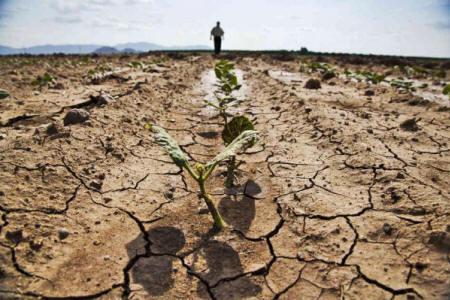|
from
OccupyCorporatism Website
Andy Chanllinor, climate impact scientist at the University of Leeds, led a study that claims climate change will cause negative crop yields because of an expected trend in higher global temperatures.
Chanllinor explained:
Intense droughts and larger storms alter precipitation levels and are expected to add to the plight of the estimated 842 million starving people across the globe.
Interestingly, in 2012, before the drought crisis in America began to take its toll on US corn crops, Purdue and Stanford published a study that predicted with precise accuracy that man-made climate change would affect corn yields to the extent that a rise in food prices would be inevitable.
They obtained their funding from US Department of Energy's Office of Science.
The study explained with eerily that only because to man-made climate change,
However, in the US, efforts to control the weather have contributed to the extreme conditions we are experiencing.
For less than $5 billion annually, solar radiation management (SRM) could mimic the effects of a volcanic eruption with the use of sulfuric aerosols dispensed into the atmosphere.
This scheme does not reduce CO2 levels, but happens to alter the temperature and precipitation levels across the globe.
Justifying the need for a cooling effect, David Keith, director of the Institute for Sustainable Energy, Environment and Economy is pushing the releasing of nanotechnology with sulfuric aerosols into the Earth's atmosphere to reflect sunlight back out into space.
Keith manages the million-dollar geoengineering research that is funded by Bill Gates and the Fund for Innovative Climate and Energy Research.
The Texas Weather Modification Association (TWMA) combines "a lot of raw materials" into the atmosphere to assist clouds in becoming "more efficient." Despite their efforts to manipulate the weather, the Texas government has actually heightened the intensity of drought conditions in the state for the past 4 years.
Two years ago, it was found that chemtrails were polluting thunderclouds which is causing damage to the environment and the planet's natural weather patterns.
The pollution drenched thunderclouds are most pervasive at night which causes warmer temperatures. The study asserts that these clouds do not reflect sunlight, but trap heat within them and cause global warming effects.
Severe droughts have plagued the US and are expected to continue through the next two decades. Using computer models, these predictions are based on statistical data with regard to sea surface temperatures.
The National Center for Atmospheric Research (NCAR), a federally funded agency, agrees with the predictions.
Other alterations to our weather are facilitated by the phenomenon of shooting salt water into clouds to create "oceans" in our skies. These clouds, it is believed, could reflect sunlight back out, thereby cooling the planet.
Another method of changing Earth's weather is to use marine cloud brightening.
Using this brightening to manipulate the earth's weather patterns, according to climate scientists, is of no concern as far as its impact on our natural environment.
Cloud seeding, is assumed to be useful in decreasing decrease the strength of hurricanes.
By reflecting light away from the ocean surface, the theory is that these storms would pass over cooler water and not intensify. Drones could be used to spray seawater into the atmosphere, causing the clouds to thicken and last longer; thereby reflecting more sunlight out and weakening the tropical waters below.
Calculations suggest that this technique could lower the ocean's surface temperature by several degrees, which would in tow lower the strength of a hurricane by potentially one Category.
|

